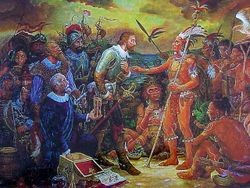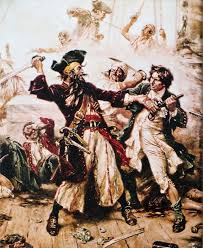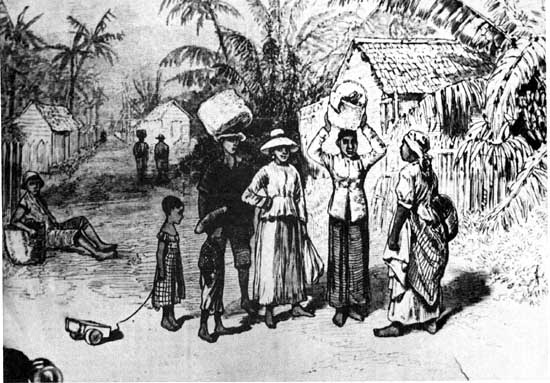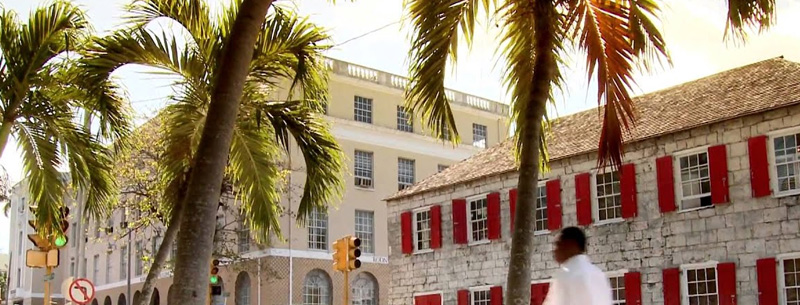The Bahamas were first inhabited by the Lucayans, a branch of the Tainos who first crossed to the islands in canoes from Hispaniola/Cuba. The Lucayans thrived on mainly the south-central area of the Bahamas and amassed a population of around 40,000 in the 800 years they spend there.
 In 1492 Christopher Columbus sailed from Spain with his three ships the Nina, Pinta, and the Santa Maria in search of Asia. On October 12 Columbus reached San Salvador in an event known as the “discovery of America”. Columbus then moved on to Cuba and Hispaniola.
In 1492 Christopher Columbus sailed from Spain with his three ships the Nina, Pinta, and the Santa Maria in search of Asia. On October 12 Columbus reached San Salvador in an event known as the “discovery of America”. Columbus then moved on to Cuba and Hispaniola.
Over the next 30 years, the Lucayans were then deported into slave labor. Nearly the entire population was relocated or wiped out. With little use for the islands the Spanish then abandoned them for 130 years but still held claims to them.
In 1648 a group from Bermuda sailed to the Bahamas to form a new colony. Due to Burmuda becoming grossly overpopulated the Bahamas offered both religious and political freedom for the settlers. When the settlers first arrived the larger ship, the William, wrecked on the reef north of Eleuthera Island. Over the next few years, the settlers struggled due to the loss of provisions, poor soil, fighting between settlers themselves, and the Spanish among other things. Many of the settlers returned to Bermuda. But a few families did choose to stay and by 1670 around 20 families were living in Eleuthera.
Soon other settlers arrived and started populating New Providence which became the center of population in the Bahamas. By 1670 almost 500 people were living in New Providence. Soon the people of Eleuthera migrated to New Providence in search of better soil for their farms making it the most populated island in the Bahamas.
However, the Bahamians soon came into conflict with the Spanish over salvaging wrecks. The Spanish raided the Bahamas and the Bahamians, in turn, commissioned privateers against Spain. In 1684 The Spanish burned down the settlements in New Providence and Eleuthera and caused the islands to become once again abandoned. In 1686 new settlers arrived in New Providence from Jamaica.

Following peace with France 1697, many privateers became pirates and soon strongly inhabited Nassau making it their base. In 1701 England soon went to war with France and Spain. With no functioning government in the Bahamas, Nassau soon became the base of operations for English privateers and pirates. The raiders often attacked French and Spanish ships and with the war ending in 1714 many of the English privateers slipped back into piracy.
One estimate guesses that over 1,000 pirates inhabited Nassau in 1713 outnumbering permanent settlers greatly. At least 20 pirate captains used Nassau as homeport during this period.
In 1718 Woodes Rogers reached Nassau with a small fleet of warships. They persuaded the pirates to surrender to the king. The 1,000 pirates surrendered peacefully and Rogers was appointed governor of the Bahamas and pardoned any pirate who surrendered to a British governor within one year.
Soon after Britain and Spain went to war and Rogers went heavily into debt attempting to build up Nassau’s defenses. In 1722 Rogers left for England to plead repayment for the money he had borrowed but instead was thrown in debtors’ prison and was replaced as governor. Rogers was soon released when his creditors absolved his debts and in 1728 Rogers was appointed Governor of the Bahamas for a second term. He died in 1732.

William Shirley was then appointed governor of the Bahamas in 1758 and served until 1770. Soon after the Bahamas fell to Spanish forces in 1782 but were later recaptured. The Bahamas was soon used to develop cotton and when the slave trade was abolished in 1807 the slaves soon became the primary inhabitants of the Bahamas.
In the 1830s and 40s, tensions rose between British and American merchant ships. Britain had notified nations that slaves brought into the Bahamas and Bermuda waters would be forfeited and freed. Many American slave ships were hijacked and the slaves were let go.
The people of the Bahamas lived normally up until around the WWII era when the Duke of Windsor was installed Governor of the Bahamas and attempted to combat mass poverty in the islands.
The islands were used for flight training by the Allies during World War II and soon after the airfield became Nassau’s international airport in 1957. This helped bring in mass tourism after Havana was closed to Americans in 1961. The islands were soon made self-governing in 1964. In 1973 soon after the Bahamas became fully independent.
